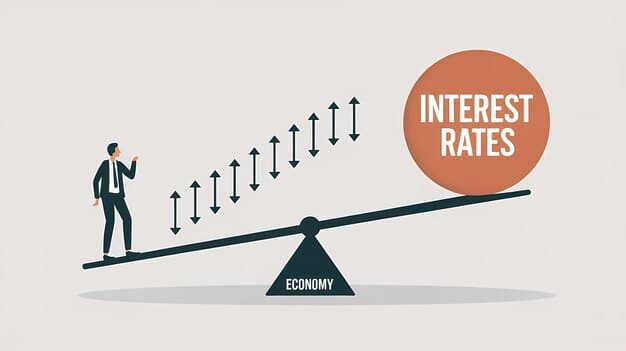Income REITs in 2025: Navigating Interest Rate Hikes

Income REITs face potential challenges and opportunities in 2025 as interest rate hikes impact their profitability and investment strategies, requiring a careful evaluation of market conditions and portfolio adjustments.
Navigating the world of Income REITs: Understanding the Impact of Interest Rate Hikes in 2025 requires a keen understanding of market dynamics and strategic financial planning, especially as interest rates continue to fluctuate and influence investment returns.
What are Income REITs?
Income REITs, or Real Estate Investment Trusts, are companies that own or finance income-producing real estate across a range of property sectors. These REITs provide investors with the opportunity to earn a share of the income from real estate without directly owning the properties themselves.
Understanding their structure and function is crucial for assessing their performance and potential in a changing economic landscape.
Types of Income REITs
Income REITs can be broadly categorized based on the type of properties they hold. These include:
- Equity REITs: Own and operate income-producing properties, earning revenue through rents.
- Mortgage REITs: Invest in mortgages and mortgage-backed securities, earning income from interest payments.
- Hybrid REITs: Combine both equity and mortgage investments to diversify their income streams.
Key Benefits of Investing in Income REITs
Investing in Income REITs offers several advantages, making them an attractive option for income-seeking investors. These benefits include:
- High Dividend Yields: REITs are required to distribute a significant portion of their taxable income to shareholders, resulting in attractive dividend payouts.
- Diversification: REITs provide exposure to the real estate market without the hassles of direct property ownership.
- Liquidity: REIT shares are traded on exchanges, offering greater liquidity compared to direct real estate investments.
Income REITs provide a conduit for individuals to invest in real estate, benefiting from regular income streams and potential capital appreciation, while also navigating the complexities of the real estate market.
Interest Rate Hikes: The Economic Context for 2025
Interest rate hikes, implemented by central banks such as the Federal Reserve, are designed to control inflation by increasing the cost of borrowing money. These rate adjustments have wide-ranging effects on the economy, including the real estate sector and, consequently, Income REITs.
Forecasting the economic landscape for 2025 involves considering various factors and their potential effects on REIT performance.

Impact of Interest Rates on Real Estate
Higher interest rates can impact the real estate market in several ways:
- Increased costs of borrowing for property developers, which can lead to a slowdown in new construction.
- Higher mortgage rates reduce affordability for homebuyers, potentially cooling the housing market.
- Commercial real estate may see reduced demand as businesses face increased borrowing costs.
Forecasting Interest Rates for 2025
Predicting interest rates is complex, but analyzing current trends and expert opinions can provide insights. Factors to consider include:
- Inflation rates and the central bank’s monetary policy responses.
- Economic growth indicators, such as GDP and employment data.
- Global economic conditions and geopolitical events.
Understanding these macro-economic factors is vital for assessing their influence on Income REITs and their investment strategies in a rising rate environment.
How Interest Rate Hikes Affect Income REITs
Interest rate hikes have a direct impact on Income REITs, influencing their borrowing costs, property valuations, and overall profitability. Understanding these effects is essential for investors seeking to navigate the REIT landscape effectively.
The interplay between interest rates and REITs is complex, requiring a multifaceted approach to analyze and forecast potential outcomes.
Increased Borrowing Costs
One of the most immediate effects of interest rate hikes on Income REITs is the increase in borrowing costs. REITs often rely on debt to finance property acquisitions and development projects. Higher interest rates can:
- Reduce the profitability of new investments due to higher financing costs.
- Increase the debt burden on existing loans, especially those with variable interest rates.
- Potentially lead to lower dividend payouts if profits are squeezed.
Impact on Property Valuations
Rising interest rates can also affect property valuations, which in turn impacts the net asset value (NAV) of Income REITs. Key considerations include:
- Higher capitalization rates (cap rates) as borrowing costs increase, leading to lower property values.
- Reduced demand for commercial real estate as businesses face higher operating costs.
- Potential for decreased rental income if economic conditions weaken.

By understanding these market mechanisms, investors can better assess risks and potential returns associated with Income REIT investments during periods of rising interest rates.
Strategies for Income REITs to Adapt to Rising Interest Rates
To mitigate the risks associated with rising interest rates, Income REITs can adopt several proactive strategies aimed at stabilizing their financial performance and maintaining attractive returns for investors. Adapting these strategies is essential for long-term sustainability and profitability.
These strategies include financial and operational adjustments that can help REITs navigate the complexities of a high-interest-rate environment.
Reducing Debt Exposure
One effective strategy is for Income REITs to reduce their debt exposure. This can be achieved through:
- Selling assets to generate cash for debt repayment.
- Refinancing existing debt to secure lower fixed interest rates.
- Issuing equity to reduce the overall debt-to-equity ratio.
Focusing on High-Quality Properties
Investing in high-quality properties in prime locations can help REITs maintain occupancy rates and rental income even during economic downturns. Key considerations include:
- Properties with long-term leases and strong tenant profiles.
- Locations with high demand and limited supply.
- Properties with potential for value appreciation.
Diversifying Property Types
Diversifying property types can help mitigate risks associated with downturns in specific sectors. REITs can:
- Expand into different property types, such as residential, industrial, or healthcare.
- Invest in REITs with diverse property portfolios.
- Conduct thorough market research to identify opportunities and potential risks.
These proactive initiatives can enable Income REITs to enhance their resilience, ensuring stable and attractive returns for investors despite the challenges posed by rising interest rates.
Analyzing Income REIT Performance in a High-Interest-Rate Environment
Evaluating the performance of Income REITs during periods of high interest rates requires a comprehensive approach that considers numerous financial metrics, market indicators, and management strategies. Understanding these analytical tools is crucial for making informed investment decisions.
By scrutinizing key performance indicators, investors can gauge the real impact of interest rate hikes on REIT profitability and sustainability.
Key Financial Metrics to Watch
Several financial metrics can help investors assess the impact of interest rate hikes on Income REITs. These include:
- Funds from Operations (FFO): Measures the cash flow generated from the REIT’s operations.
- Net Asset Value (NAV): Represents the estimated market value of the REIT’s assets, less liabilities.
- Dividend Yield: Indicates the annual dividend payout as a percentage of the REIT’s share price.
Comparing REIT Performance Against Benchmarks
Comparing REIT performance against industry benchmarks provides insights into their performance relative to peers. Benchmarks to consider include:
- REIT Indexes: Such as the MSCI US REIT Index.
- Peer Groups: REITs with similar property types and investment strategies.
- Historical Performance: REIT’s past performance during similar economic conditions.
A thorough analysis of these factors allows investors to assess the true impact of interest rate hikes on Income REITs, enabling evidence-based and strategic portfolio decisions.
Future Outlook for Income REITs in 2025
The landscape for Income REITs in 2025 will be shaped by prevailing interest rates, economic conditions, and evolving market dynamics. Gaining insights into potential trends and opportunities will be vital for investors seeking strong returns.
Looking ahead, Income REITs will need to adapt and innovate to remain competitive and appealing to investors.
Potential Opportunities for Income REITs
Despite the challenges posed by rising interest rates, Income REITs can capitalize on several growth opportunities:
- Investing in Undervalued Properties: Identifying and acquiring properties that are undervalued due to market conditions.
- Focusing on High-Growth Sectors: Investing in property sectors with strong growth potential, such as data centers or logistics facilities.
- Enhancing Property Management: Improving operational efficiency and tenant relations to maximize rental income.
Risks and Challenges to Consider
Investors should also be aware of potential risks and challenges facing Income REITs in 2025. These include:
- Economic Recession: A potential economic downturn could reduce demand for commercial real estate and impact rental income.
- Increased Competition: A growing number of REITs could intensify competition for investment opportunities.
- Regulatory Changes: Changes in tax laws or regulations could affect REIT profitability.
By carefully analyzing the macroeconomic and sector-specific trends, investors can make well-informed decisions, optimizing their investment portfolios for potentially positive outcomes in the future Income REIT market.
| Key Point | Brief Description |
|---|---|
| 📈 Interest Rate Impact | Higher rates increase borrowing costs for REITs, affecting profitability. |
| 🏘️ Valuation Risks | Property values may decline as cap rates rise with interest rates. |
| 🛡️ Adaptation Strategies | REITs can reduce debt, focus on quality properties, and diversify. |
| 🔮 Future Outlook | Opportunities exist in undervalued assets and high-growth sectors. |
Frequently Asked Questions
The main types of Income REITs are equity REITs (owning properties), mortgage REITs (investing in mortgages), and hybrid REITs (combining both strategies for diversified income).
Interest rate hikes can decrease property values because borrowing becomes more expensive, leading to higher cap rates and reduced demand for commercial real estate.
Strategies include reducing debt exposure, focusing on high-quality properties with strong tenants, and diversifying into different property sectors to mitigate risk.
Key metrics include Funds From Operations (FFO), Net Asset Value (NAV), and dividend yield to assess the REIT’s cash flow, asset value, and payout sustainability.
Opportunities include investing in undervalued properties, focusing on high-growth sectors like data centers, and enhancing property management for maximized rental income.
Conclusion
In conclusion, navigating the landscape of Income REITs in 2025 requires a thorough understanding of the impact of interest rate hikes, proactive adaptation strategies, and continuous monitoring of key performance indicators to make informed investment decisions in a dynamic market environment.





